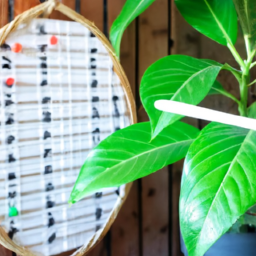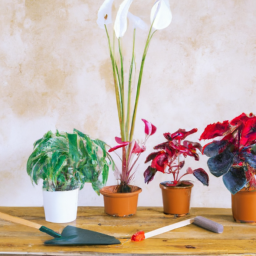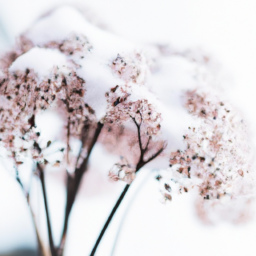
Summer is finally here, and with it comes the scorching heat and high humidity that can leave us feeling drained and uncomfortable. But it’s not just us humans who struggle during this time of year – our plants also need some extra care and attention to thrive in these conditions. In this blog post, we will explore some effective summer strategies to combat the heat, humidity, and keep our beloved plants happy and healthy. So, whether you’re a seasoned gardener or just starting out, let’s dive into the world of Summer Strategies: Heat, Humidity, and Keeping Your Plants Happy.
Summer Strategies: Heat, Humidity, and Keeping Your Plants Happy
Tips for Protecting Your Plants from Summer Heat and Humidity
Welcome to our guide on summer strategies for keeping your plants happy and healthy in the scorching heat and high humidity. As an expert in plant care, I will provide you with valuable tips and insights to ensure your plants thrive during the summer months.
Understanding the Impact of Heat and Humidity on Plants
Before we dive into the strategies, it’s important to understand how heat and humidity affect your plants. High temperatures can lead to excessive evaporation, causing your plants to lose moisture rapidly. On the other hand, high humidity levels can create a breeding ground for fungal diseases and attract pests. Finding the right balance is crucial for the well-being of your plants.
To protect your plants, follow these step-by-step strategies:
1. Provide Adequate Watering
Watering is the key to keeping your plants hydrated during hot summer days. However, it’s essential to water them correctly. Deep watering is more effective than frequent shallow watering. This encourages the plants’ roots to grow deeper, making them more resilient to heat stress. Water your plants in the early morning or late evening when the temperatures are cooler, minimizing evaporation.
Consider using a drip irrigation system or soaker hoses to deliver water directly to the plants’ roots. This reduces water waste and ensures efficient hydration. Mulching around your plants also helps retain moisture in the soil and prevents weed growth, which competes for water resources.
Monitor the moisture levels in the soil regularly. Stick your finger about an inch into the soil, and if it feels dry, it’s time to water. Remember, overwatering can be as harmful as underwatering, so strike a balance.
2. Shield Your Plants from Direct Sunlight
While sunlight is essential for photosynthesis, excessive heat and intense sunlight can damage your plants. Consider providing shade during the hottest parts of the day, especially for delicate or potted plants. You can use shade cloth, umbrellas, or even move them to a shaded area temporarily. Be mindful of the changing position of the sun throughout the day and adjust the shade accordingly.
Another effective method is to create a natural shade canopy by planting taller, heat-tolerant plants around your more vulnerable plants. This not only provides shade but also improves air circulation, reducing the temperature around the plants.
Additionally, you can use reflective mulch or white fabric to cover the soil surface around your plants. This helps reflect sunlight back up towards the foliage, reducing heat stress.
3. Enhance Air Circulation
Proper air circulation is vital for preventing fungal diseases and maintaining plant health. Trim any overgrown branches or foliage that may obstruct airflow. Avoid overcrowding your plants, as this can create a humid microclimate and increase the risk of diseases.
Strategically placing fans near your plants can also help improve air movement. The gentle breeze created by the fans not only cools the plants but also deters pests like mosquitoes.
Remember to regularly clean your fans and remove any debris or dust that may accumulate, as this can hinder their effectiveness.
4. Choose Heat-Tolerant and Drought-Resistant Plants
One of the best ways to combat summer heat and humidity is to select plants that are naturally adapted to such conditions. Research and choose heat-tolerant and drought-resistant plant varieties for your garden. These plants are better equipped to withstand the harsh summer conditions and require less maintenance.
Some examples of heat-tolerant plants include succulents, cacti, lavender, and yarrow. These plants have developed mechanisms to conserve water and thrive in arid environments.
Before planting, ensure your soil is well-draining to prevent waterlogging, which can lead to root rot. Amending your soil with organic matter can improve its drainage capabilities.
5. Monitor and Control Pests and Diseases
High humidity can create a favorable environment for pests and diseases to thrive. Regularly inspect your plants for any signs of infestation or disease. Look for discolored leaves, spots, wilting, or unusual growth patterns.
If you detect any issues, promptly take appropriate measures to control them. This may involve using organic insecticides, fungicides, or implementing cultural practices like pruning infected areas or removing affected plants. Remember to follow the instructions on the product labels and consider environmentally friendly options.
Implementing these strategies will significantly increase the chances of your plants surviving and thriving during the summer months. Remember to observe your plants closely and make adjustments as needed. With proper care, your plants will not only survive but also flourish, providing you with a beautiful and vibrant garden throughout the summer season.

Effective Watering Techniques to Keep Your Plants Thriving in the Summer
Understanding the Importance of Proper Watering
When it comes to keeping your plants happy and healthy during the scorching summer months, proper watering techniques play a crucial role. Water is essential for all living organisms, and plants are no exception. It is through water that plants absorb nutrients, maintain their structure, and carry out various metabolic processes.
However, watering your plants is not as simple as just pouring water on them. It requires understanding the specific needs of different plants, the environmental factors affecting water availability, and the best practices for efficient watering. In this guide, we will delve into effective watering techniques that will help your plants thrive even in the hottest of summers.
1. Know Your Plants’ Watering Needs
Each plant has its own unique watering requirements, and it’s crucial to know them to provide adequate moisture. Some plants prefer consistently moist soil, while others thrive in drier conditions. Research the watering needs of the plants in your garden and group them accordingly.
Plants with similar watering needs can be placed together, making it easier to provide the right amount of water. For example, succulents and cacti are drought-tolerant plants that require infrequent watering, while leafy greens and herbs may need more frequent watering to stay hydrated.
Remember that overwatering can be just as harmful as underwatering. It can lead to root rot and other fungal diseases, depriving the plants of oxygen and causing them to wilt or die. Observing your plants and monitoring the moisture levels in the soil will help you strike the right balance.
2. Water Deeply and Infrequently
Shallow watering can result in weak and shallow root systems, making plants more susceptible to heat stress. Instead, water your plants deeply, allowing the water to penetrate the soil and reach the roots. This encourages the roots to grow deeper, making the plants more resilient to drought conditions.
Watering deeply also helps prevent water loss through evaporation. When you water the surface of the soil lightly, the water quickly evaporates, leaving the roots thirsty. By watering deeply, you ensure that the moisture reaches the root zone where it is needed the most.
However, it’s important to note that watering deeply doesn’t mean watering excessively. The frequency of watering will depend on various factors such as the plant’s water requirements, soil type, and weather conditions. As a general rule, aim to water your plants when the top inch of soil feels dry.
3. Time Your Watering Wisely
The timing of watering can significantly impact the effectiveness of your watering efforts. Watering during the cooler parts of the day, such as early morning or late evening, allows the plants to absorb the moisture before the heat of the day sets in. This reduces water loss through evaporation and ensures that the plants have enough water to withstand the hot temperatures.
Watering during the midday heat is not recommended as the water droplets can act as magnifying glasses, intensifying the sunlight and potentially scorching the leaves. Additionally, watering at night can create a damp environment that promotes fungal growth, so it’s best to avoid it as well.
Observe your plants and monitor their moisture levels regularly to determine the optimal watering schedule. Adjust the frequency and timing of watering based on the weather conditions and the specific needs of your plants.
Conclusion
Proper watering techniques are essential for the health and vitality of your plants, especially during the summer when the heat and humidity can pose challenges. Understanding your plants’ watering needs, watering deeply and infrequently, and timing your watering wisely are key steps to ensure their survival and growth.
By following these effective watering techniques, you can help your plants thrive even in the hottest summer months. Remember, each plant is unique, so it’s important to observe and adapt your watering practices accordingly. With a little care and attention, your plants will reward you with lush foliage, vibrant blooms, and a garden that flourishes throughout the summer season.

Choosing Heat-Tolerant Plants for a Happy and Healthy Summer Garden
Summer is a wonderful time to enjoy your garden, but the scorching heat and humidity can take a toll on your plants. To ensure a happy and healthy summer garden, it is crucial to choose heat-tolerant plants that can withstand the challenging weather conditions. In this article, we will discuss some strategies to help you select the right plants for your summer garden.
1. Research Heat-Tolerant Plant Varieties
When it comes to choosing heat-tolerant plants, it is essential to do your research. Look for plants that are known for their ability to thrive in hot and humid climates. Some popular heat-tolerant plant varieties include:
– Succulents: Succulents are excellent choices for summer gardens as they have thick, fleshy leaves that store water, making them highly drought-resistant.
– Ornamental Grasses: Ornamental grasses are not only heat-tolerant but also add a touch of elegance to your garden. They come in various heights, colors, and textures, offering a wide range of options to suit your garden’s aesthetics.
– Tropical Plants: Many tropical plants, such as hibiscus, bougainvillea, and palm trees, thrive in hot and humid conditions. These plants can add a vibrant and exotic feel to your summer garden.
2. Consider Native Plants
Native plants are well-adapted to the local climate and often have natural defenses against the challenges posed by extreme heat and humidity. They have evolved to survive in the specific conditions of your region, making them an excellent choice for a summer garden. Research native plants in your area and incorporate them into your garden for a more sustainable and resilient landscape.
Native plants not only tolerate the summer heat but also provide valuable habitat for local wildlife, such as birds and butterflies. By choosing native plants, you can create a thriving ecosystem in your garden while minimizing the need for excessive watering and maintenance.
3. Provide Adequate Watering and Mulching
Even heat-tolerant plants require regular watering during the hot summer months. It is crucial to provide them with adequate moisture to keep them happy and healthy. Deep watering is more effective than frequent shallow watering as it encourages plants to develop deep root systems, making them more resilient to drought conditions.
In addition to proper watering, mulching is another essential strategy to help your plants beat the heat. Apply a layer of organic mulch, such as wood chips or straw, around your plants to conserve moisture, suppress weed growth, and regulate soil temperature. Mulching also improves soil structure and fertility, promoting overall plant health.
Remember to monitor your plants’ water needs and adjust your watering schedule accordingly. Overwatering can be just as harmful as underwatering, so strike a balance to ensure the optimal health of your plants.
By following these strategies and choosing heat-tolerant plants, you can create a beautiful and thriving summer garden that can withstand the challenges of heat and humidity. Remember to research plant varieties, consider native plants, and provide adequate watering and mulching. With proper care and attention, your plants will flourish, and you can enjoy a vibrant and lush garden all summer long.
Recap of this article
Summer can be a challenging time for gardeners as the scorching heat and high humidity can take a toll on our beloved plants. But fear not, because there are several strategies you can employ to ensure your plants stay happy and healthy during the summer months.
First and foremost, it’s crucial to provide adequate hydration to your plants. Just like us, plants need water to survive, and during the summer, they require even more. Make sure to water your plants deeply and regularly, preferably in the early morning or late evening when the temperatures are cooler. Additionally, consider using mulch around your plants to retain moisture and prevent evaporation.
Another important aspect to consider is providing shade for your plants. The intense summer sun can be too harsh for some plants, causing them to wither and wilt. Consider using shade cloths, umbrellas, or even strategically placing potted plants to create a shaded area. This will help protect your plants from the scorching sun and reduce the risk of sunburn.
Furthermore, it’s essential to keep an eye out for pests and diseases that thrive in hot and humid conditions. Regularly inspect your plants for any signs of infestation or damage, and take appropriate measures to control them. This may include using organic insecticides or introducing beneficial insects to your garden.
Lastly, don’t forget to fertilize your plants during the summer. The heat and humidity can deplete the nutrients in the soil, so it’s crucial to replenish them. Opt for slow-release fertilizers that will provide a steady supply of nutrients over time.
By following these summer strategies, you can ensure your plants stay happy and thrive even in the hottest and most humid conditions. Remember, a little extra care goes a long way in keeping your garden vibrant and beautiful throughout the summer season.
Frequently Asked Questions (FAQ):
Q1: How can I protect my plants from the heat and humidity during summer?
A1: To protect your plants from the summer heat and humidity, you can start by providing adequate shade to prevent direct sunlight from scorching the leaves. Using mulch around the base of your plants will help retain moisture in the soil and regulate temperature. Additionally, regular watering in the early morning or late evening when temperatures are cooler will keep your plants hydrated and reduce stress.
Q2: What are some strategies to keep potted plants cool during hot summer days?
A2: To keep potted plants cool in the summer, you can move them to a shaded area or use shade cloth to filter the sunlight. Placing the pots on a tray filled with water will create a cooling effect through evaporation. It’s also important to avoid overcrowding pots, as this can trap heat. Consider grouping plants with similar temperature and humidity preferences together to ensure they thrive.
Q3: How can I prevent heat stress in my plants during the summer months?
A3: Preventing heat stress in your plants involves various measures. One key step is to regularly check the soil moisture levels and adjust watering accordingly. Adequate hydration helps plants cope with high temperatures. Applying a layer of organic mulch around the base of your plants will also insulate the roots and conserve moisture. Lastly, consider using shade cloth or erecting temporary structures to provide shade during the hottest parts of the day.
Q4: Are there any specific plants that thrive in high heat and humidity?
A4: Yes, there are several plants that thrive in high heat and humidity. Some examples include tropical plants like hibiscus, bougainvillea, and plumeria. Succulents, such as aloe vera and agave, are also well-suited to these conditions. Additionally, many herbs like basil, mint, and rosemary can handle the heat and humidity. It’s always a good idea to research specific plant varieties that are known to thrive in your particular climate.
Q5: How can I identify signs of heat or humidity stress in my plants?
A5: Signs of heat or humidity stress in plants can manifest in various ways. Look out for wilting leaves, yellowing or browning of leaves, and stunted growth. Excessive leaf drop or an overall droopy appearance can also indicate stress. If you notice these signs, it’s important to take immediate action by adjusting watering schedules, providing shade, or improving air circulation around the plants.

James Wong is a renowned ethnobotanist, plant scientist, and local television presenter. With a passion for demystifying plant science, he is known for translating complex botanical concepts into practical advice for everyday plant enthusiasts. James’s expertise spans from traditional gardening to cutting-edge plant technologies, making his insights accessible and informative.


